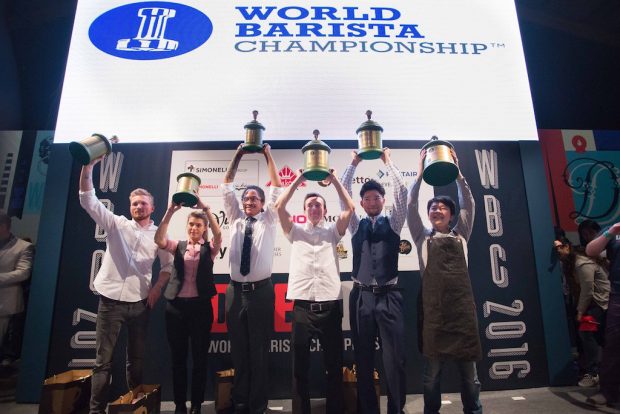
World Coffee Events photo. Lem Butler (center left) pictured with the 2016 World Barista Championship finalists, including WBC winner Berg Wu of Taiwan (far right).
Counter Culture Coffee is capitalizing on the well-earned success of longtime employee and decorated barista competitor Lem Butler by offering coffee harvested from the same farm and from approximately the same time as the coffee Butler used during the recent World Barista Championship in Dublin.
Billing the offering as “Lem’s Competition Coffee,” the offering consists of 4 ounces of Gesha-variety coffee from Finca Nuguo in Jurutungo, Panama, where Butler traveled to select coffees for his winning United States Barista Championship routine and for his World Barista Championship routine, which placed Butler fourth among 61 of the world’s top baristas.
Counter Culture said the coffee, harvested in March to replicate the coffee Butler used for the WBC, was roasted specifically for espresso brewing, offering notes of citrus and florals, and the flavor of key lime pie when used as a cappuccino component.
We’ve seen some notably expensive coffees come to pass recently, like the $65-per-6-ounce-bag Yemen Hayma Hussein al-Haba from Blue Bottle Coffee, and the CCC Finca Nuoga is selling for $24.95 per 4-ounce bag, including custom box packaging. Like Blue Bottle’s Yemeni Coffee, imported by Mokhtar Alkhanshali, the marketing behind Lem’s coffee tells an origin story, that of the Gallardo family’s small network of coffee farms in Panama.
“Between November 2014 and today, the events that have taken place can only be described as revolutionary, and one of the best Cinderella stories in coffee,” CCC said of the recent quality-focused development taking place at Finca Nuguo. “Based upon conversations the Gallardo family had with Counter Culture — and with other coffee professionals and buyers — the Gallardos refined their processing and did a lot of tiny experimental samples to refine the quality of their coffee. We have tasted coffee dried to different moisture levels and small selections processed as pulp-natural and natural sundried. They divided the five hectare farm further to make even-smaller, unique lots.”
Nick Brown
Nick Brown is the editor of Daily Coffee News by Roast Magazine.






Comment